I try my hardest not to have 50 bottles of sauces and condiments in my fridge. Instead, I stock up on the basics and try to make my own sauces whenever possible. This simple balsamic glaze (or balsamic reduction) is SUPER easy to make at home, it only takes a few ingredients, and about 10 minutes to make at home. So it just makes sense to make homemade balsamic glaze whenever I need it instead of having that extra bottle cluttering up the fridge. Plus, a little drizzle of this sweet and tangy glaze will take any salad, grilled meat, or flatbread to the next level!
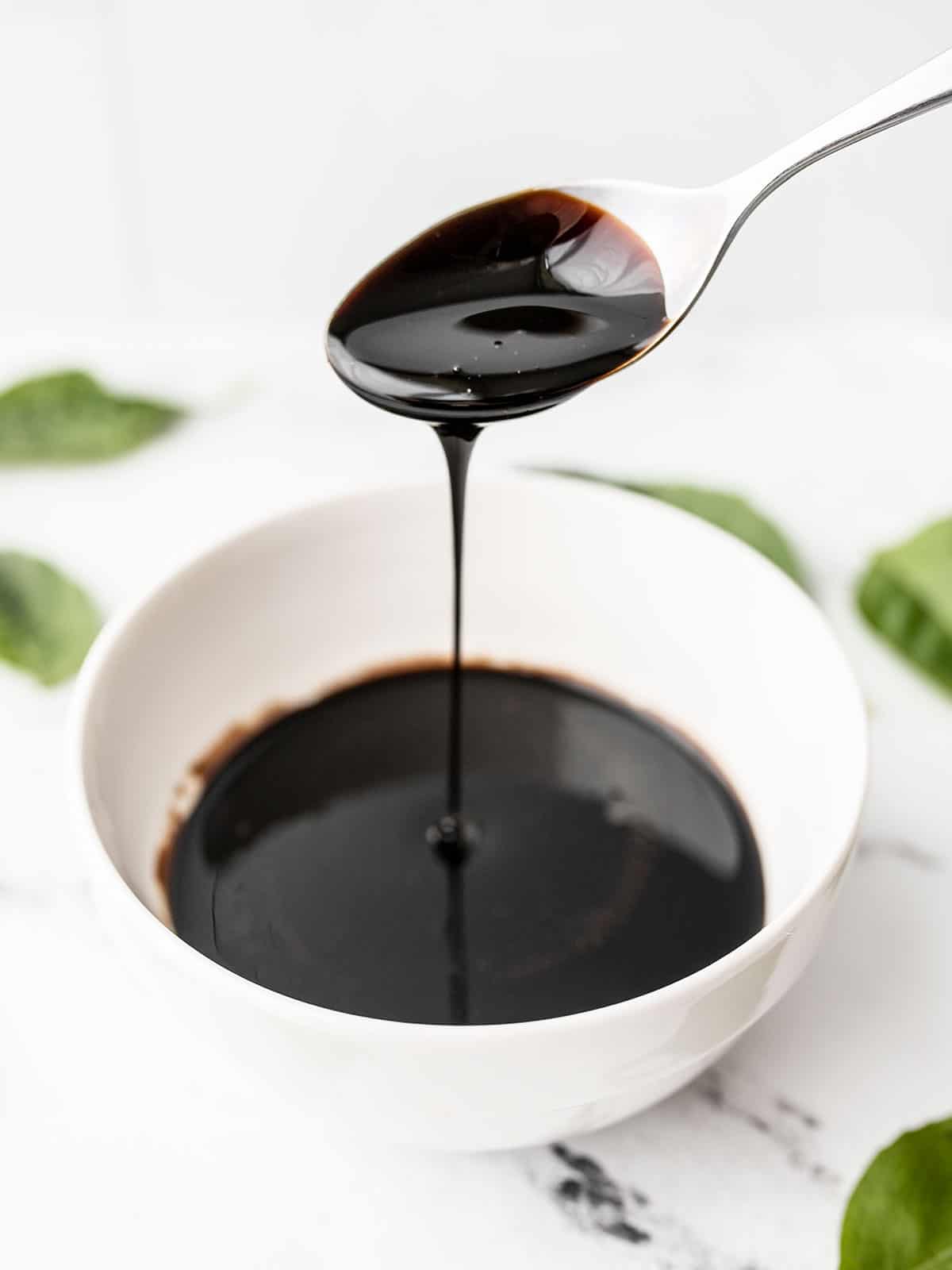
All recipes are rigorously tested in our Nashville Test Kitchen to ensure they are easy, affordable, and delicious.
What is a Balsamic Glaze?
Balsamic glaze, sometimes called a balsamic reduction, is balsamic vinegar that has been simmered until most of the water has evaporated away, leaving a deliciously thick, syrupy glaze with a bold flavor. The flavor is slightly sweet, tangy, super complex, and it tastes great drizzled over all roasted vegetables, grilled meat, pasta, pizza, and more. It is truly a magic bullet to making your food taste gourmet.
Ingredients for Balsamic Glaze
You only need two simple ingredients to make the incredibly complex and delicious flavor in this balsamic glaze! Here’s what you’ll need:
- Balsamic Vinegar: Balsamic vinegar is the base ingredient for this glaze and it gives the sauce a rich and complex flavor that is both tangy and slightly sweet.
- Brown Sugar: Brown sugar balances the acidity of the balsamic vinegar giving the glaze a smoother flavor. It also helps thicken the vinegar into a sticky glaze. You can use honey in place of brown sugar, if preferred (although this will cost more). You can also skip the added sugar if you prefer a glaze with a more acidic punch.
You can also add a pinch of salt to your glaze if you prefer. Depending on how I’m using it, I find that sometimes salt can help make it pop just a bit more. If you want your balsamic glaze to be extra rich, you can melt a tablespoon of butter into the glaze after simmering.
What Kind of Balsamic Vinegar to Use
You will want to buy at least a middle-range balsamic vinegar for this recipe because as the vinegar is reduced the flavor will intensify. If the flavor is not great to begin with, it will become worse when reduced. Look for a balsamic vinegar that is labeled “from Modena.” The color should be dark and not translucent. Avoid vinegars that list wine vinegar, caramel color, or other flavorings in the ingredients.
Tips for Making Balsamic Glaze
The process of making a balsamic glaze or reduction is quite simple, but if it’s your first time, here are some helpful tips:
- Use a small, heavy-bottomed pot so the vinegar doesn’t reduce too quickly (this gives you more wiggle room before burning).
- Turn on your vent hood. Simmering vinegar can smell quite strong!
- Use a pot that is stainless steel or light in color to allow you to see the color and thickness of the dark vinegar as it reduces.
- Use the lowest heat setting that keeps the vinegar at a gentle simmer. Having the heat set too high can cause it to reduce and burn too quickly.
- Watch the vinegar closely and stir often as it simmers to prevent going too far or allowing the vinegar to burn.
- Remove the glaze from the heat when it is still slightly thinner than you’d like because it will thicken as it cools.
How to Use Balsamic Glaze
Balsamic glaze is great drizzled over roasted vegetables, like Roasted Brussels Sprouts and Roasted Carrots, or grilled and roasted meat like Herb Roasted Pork Tenderloin or Grilled Chicken. It’s also great over fresh produce like salads, sliced tomatoes, Caprese Salad, or Bruschetta. This week, I used the balsamic glaze on some Caprese pizzas (pictured below) and it’s also a great addition to a charcuterie board.
Balsamic glaze is also surprisingly good with sweet flavors, like this No-Churn Balsamic Peach Ice Cream, fresh strawberries, or grilled pineapple!
How to Store Leftovers
The great thing about this balsamic glaze recipe is that you can make it in the quantity that you need and avoid wasting ingredients or having to stock leftovers. But if you do find yourself with leftover balsamic glaze, simply let it cool to room temperature then store it in an air-tight container in the refrigerator for up to three weeks.
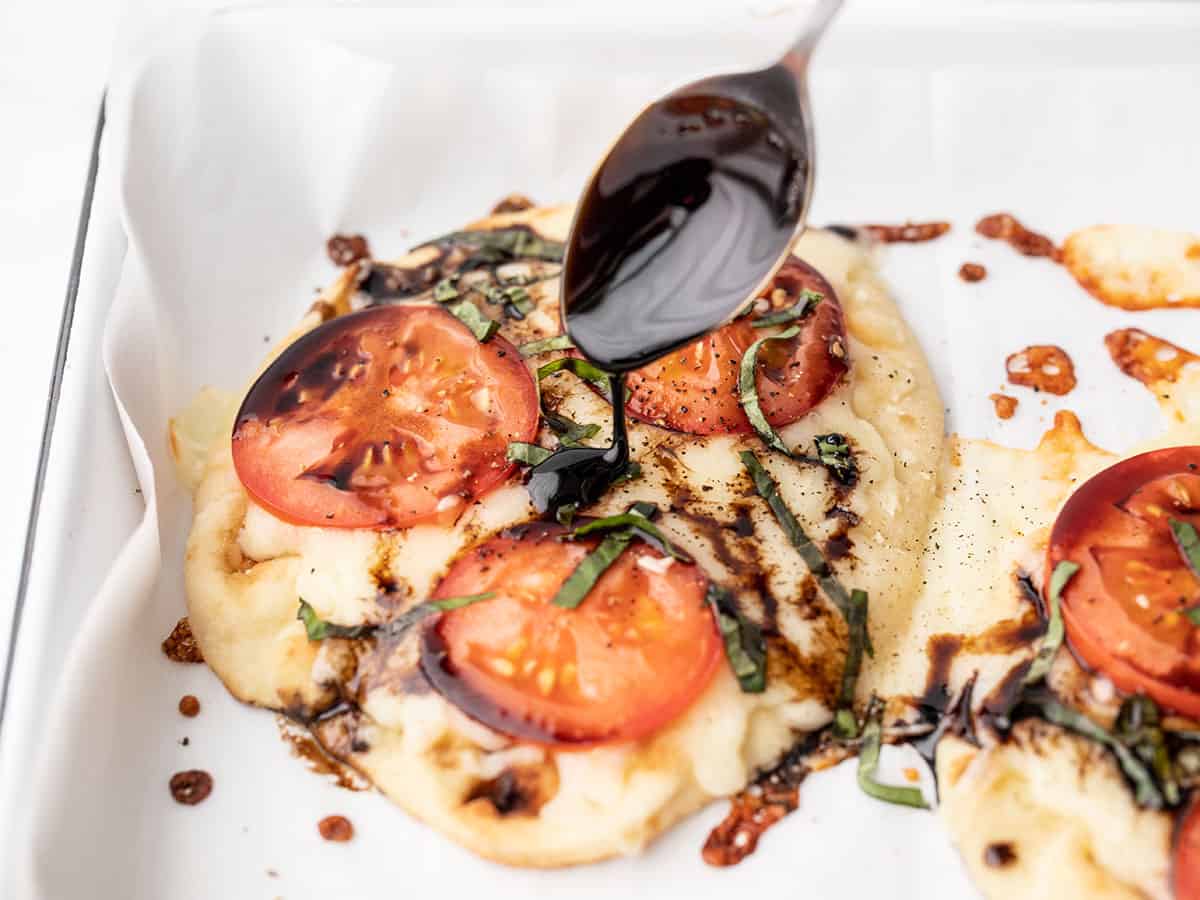
Homemade Balsamic Glaze
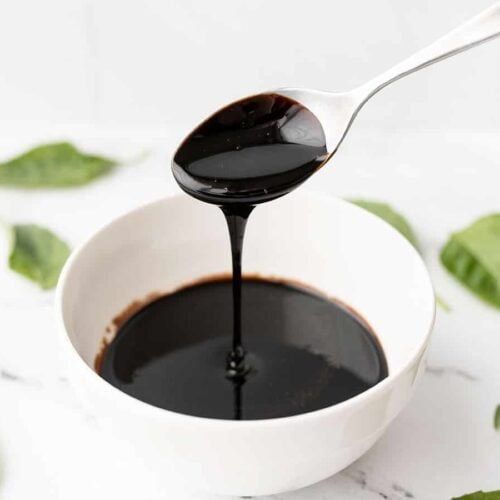
Ingredients
- 1 cup balsamic vinegar ($2.16)
- 1/4 cup brown sugar ($0.16)
Instructions
- Add the balsamic vinegar and brown sugar to a small saucepot. Stir to dissolve the sugar.
- Bring the mixture up to a simmer over medium heat. Reduce the heat to medium-low, then continue to simmer the mixture, stirring often, until it has reduced in volume by about half. This should take around ten minutes, but the total time can vary depending on your cookware, the burner, and batch size. You'll know it's done when the vinegar has thickened to the point where the simmering bubbles linger on the surface instead of immediately popping.
- Remove the glaze from the heat and allow it to cool. It will thicken considerably more as it cools. If it isn't to your desired thickness, you can simmer the glaze again to reduce it further. If the glaze is too thick, you can thin it with a small splash of water.
- Once cool, drizzle the glaze over your favorite foods and enjoy! Refrigerate leftovers until ready to use, or up to three weeks.
See how we calculate recipe costs here.
Equipment
- Liquid Measuring Cup
- Measuring Cups Spoons
Nutrition
How to Make Balsamic Glaze – Step by Step Photos
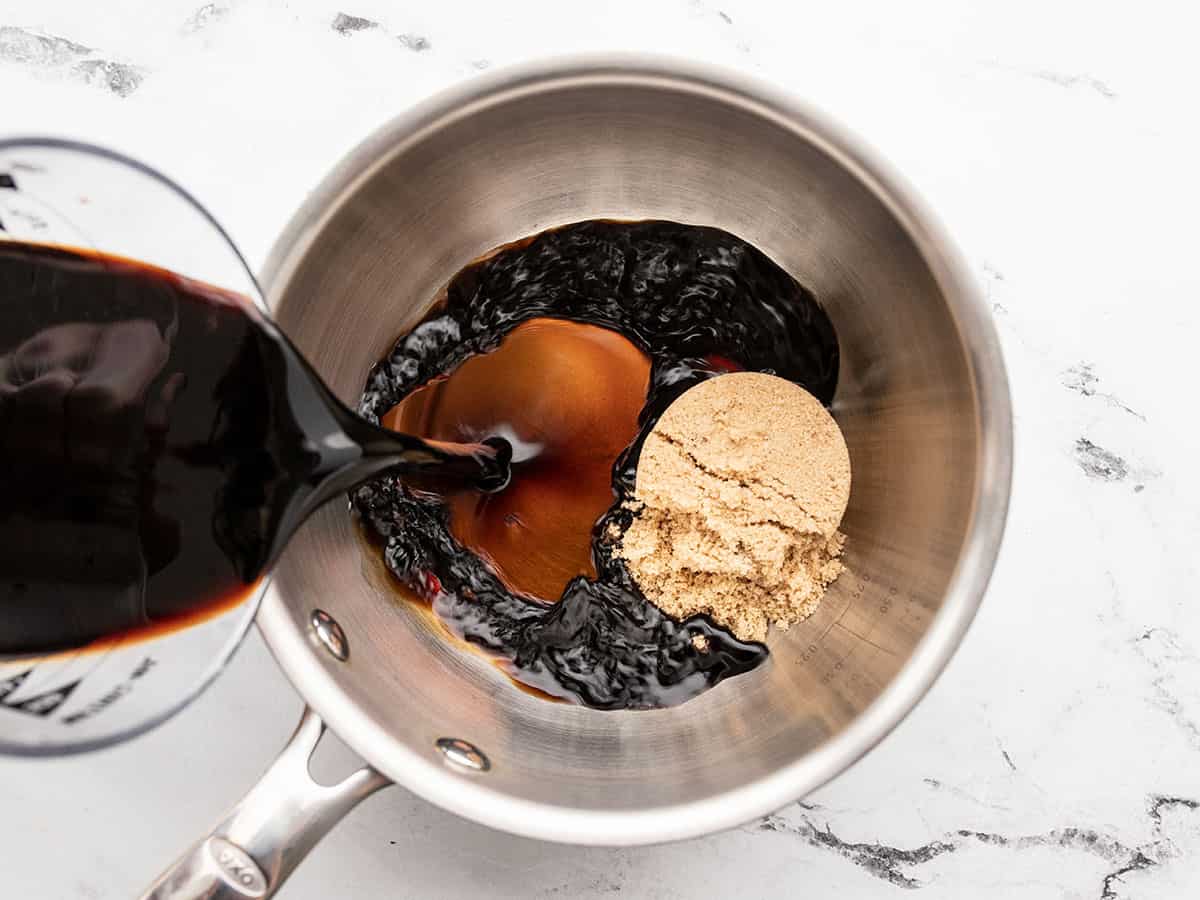
Add ¼ cup brown sugar and 1 cup balsamic vinegar to a small saucepot.
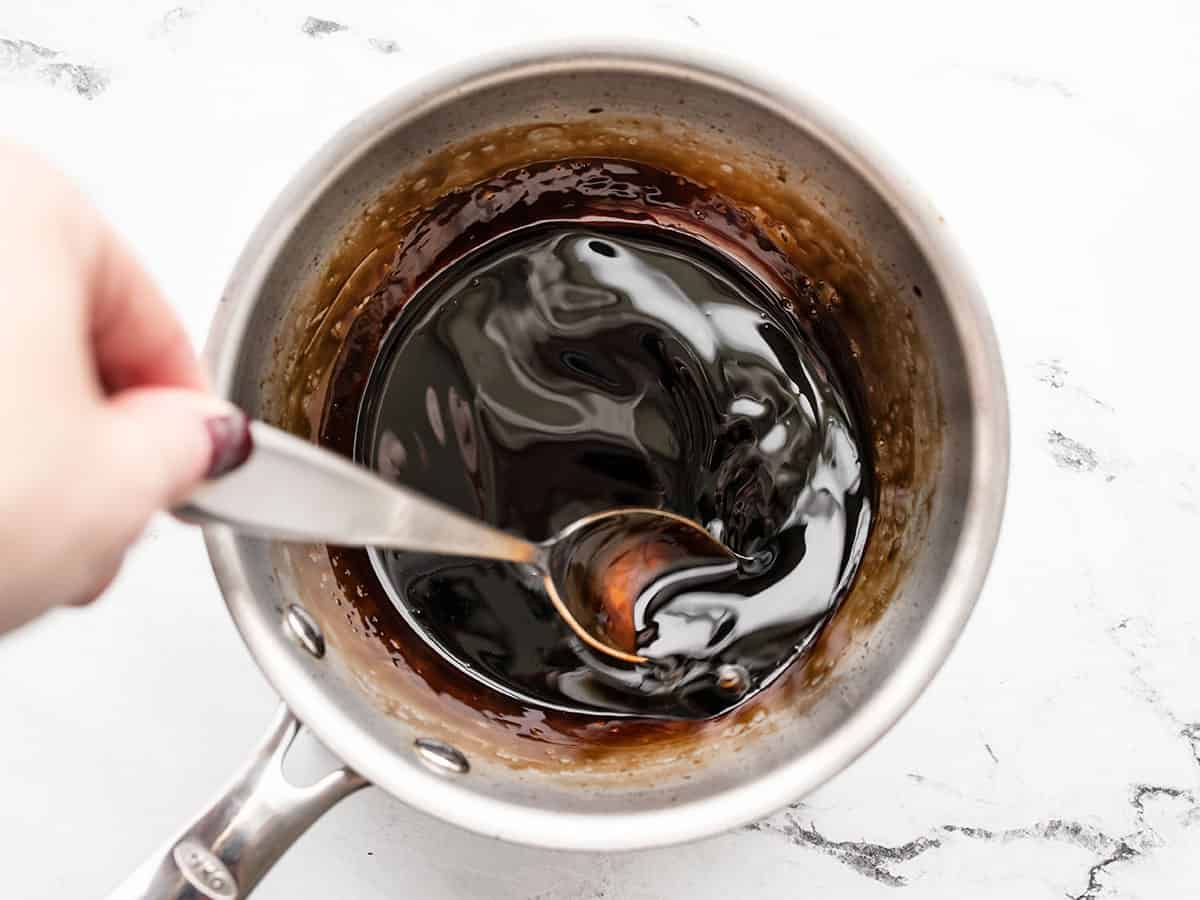
Stir the vinegar to dissolve the brown sugar. Heat the mixture over medium, allowing it to come up to a boil. Reduce the heat to medium-low and continue to gently simmer, stirring often, for about 10 minutes, or until the mixture has reduced by half. You’ll notice that as the vinegar gets thicker the bubbles from simmering take a little longer to pop on the surface.
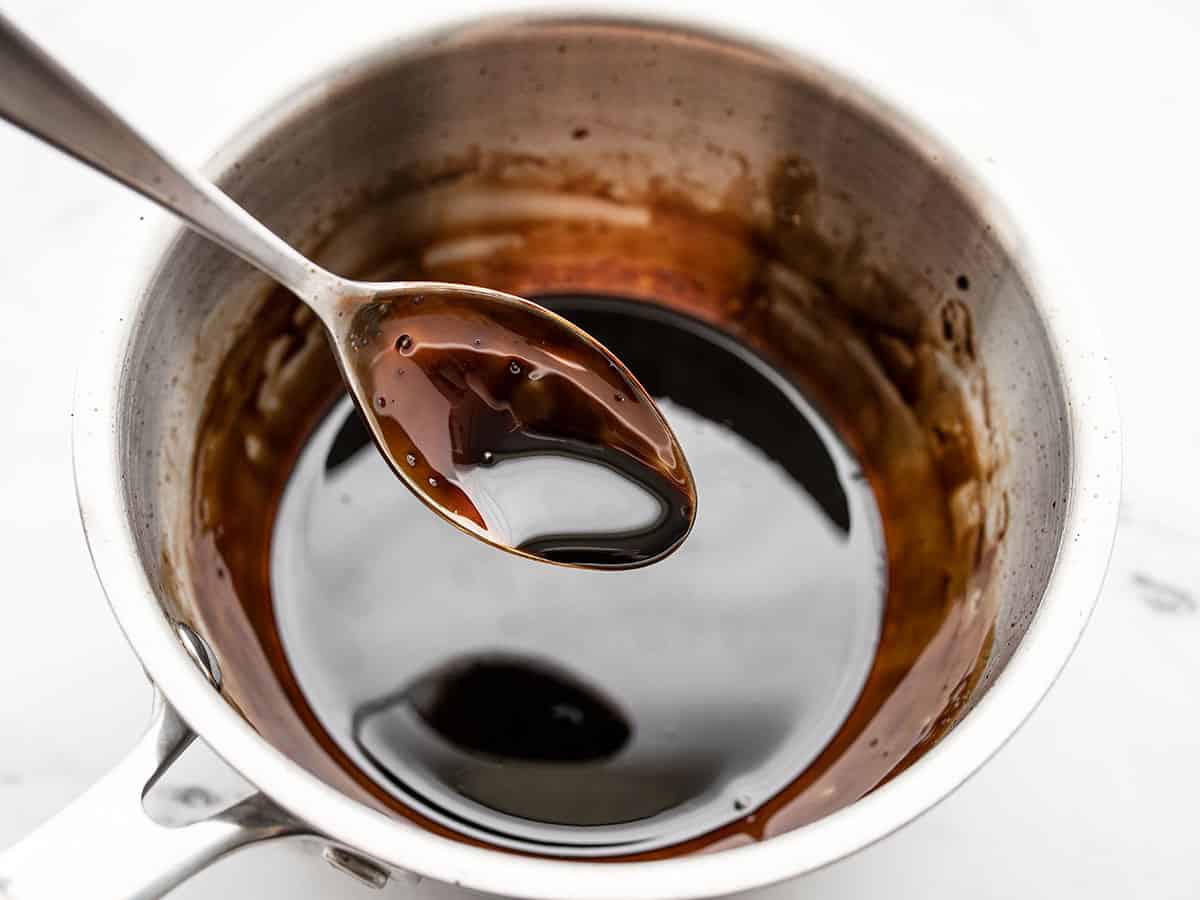
When the volume has reduced by half, remove the balsamic reduction from the heat. It will continue to thicken quite a bit as it gets closer to room temperature. If it doesn’t get as thick as you’d like, you can just simmer the glaze again.
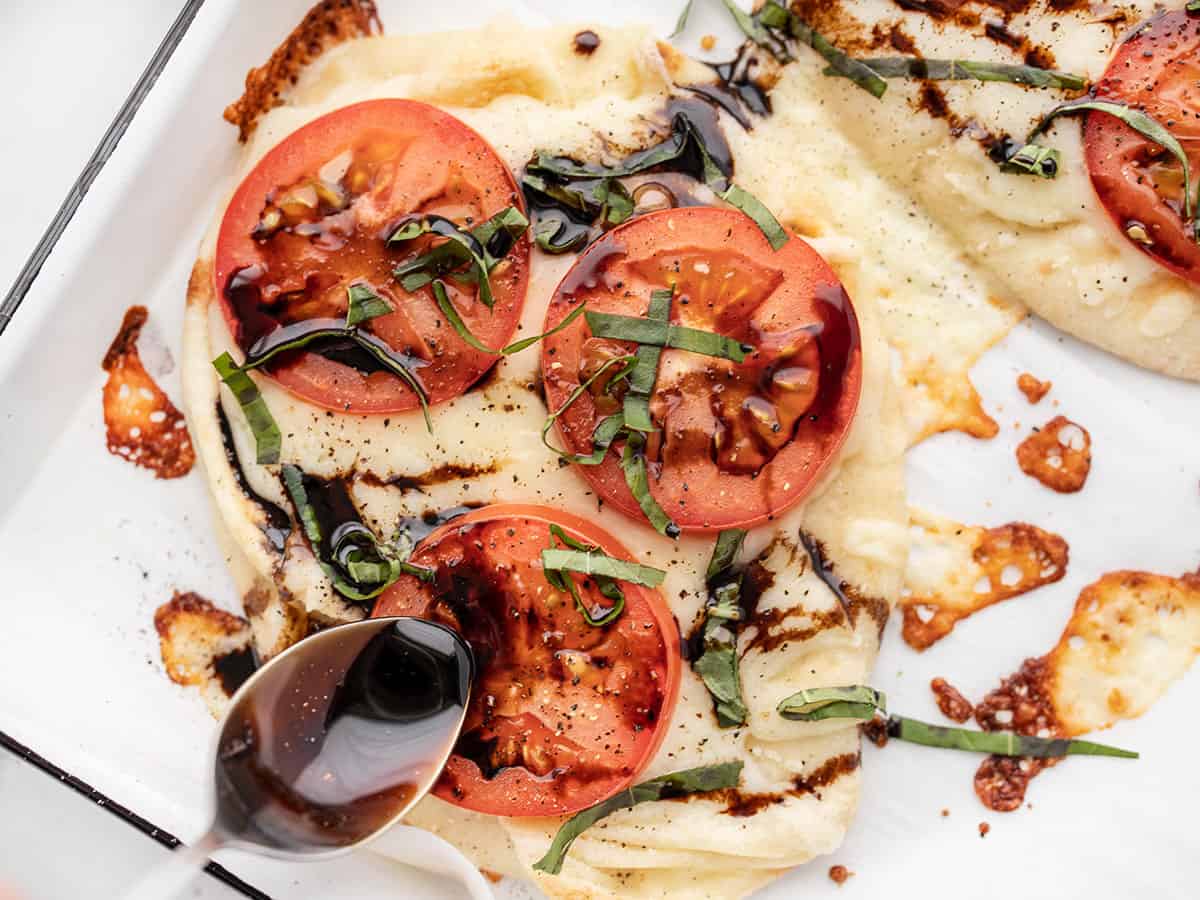
Drizzle the balsamic glaze over your favorite vegetables, pasta, salads, grilled meat, and more!


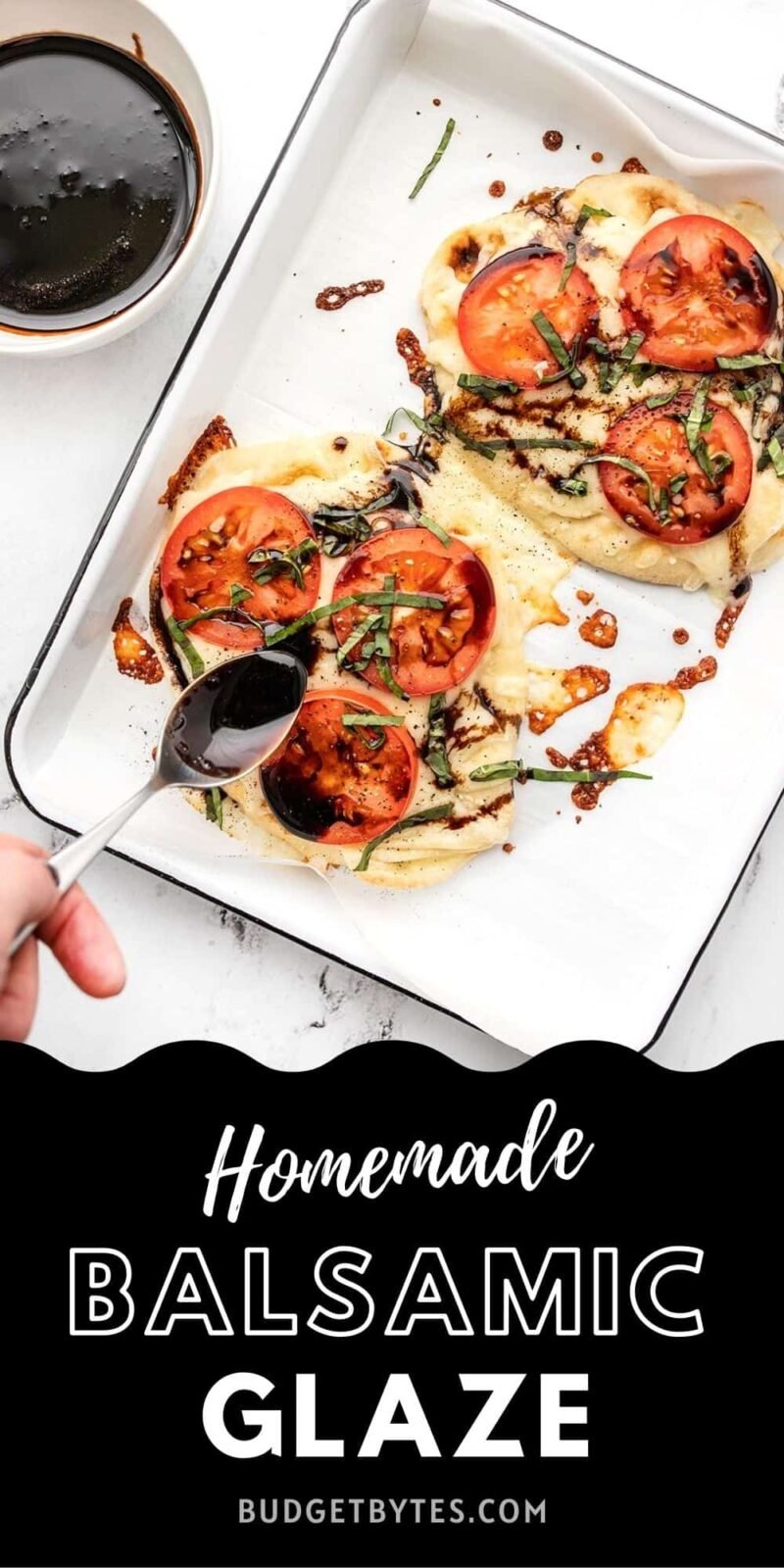
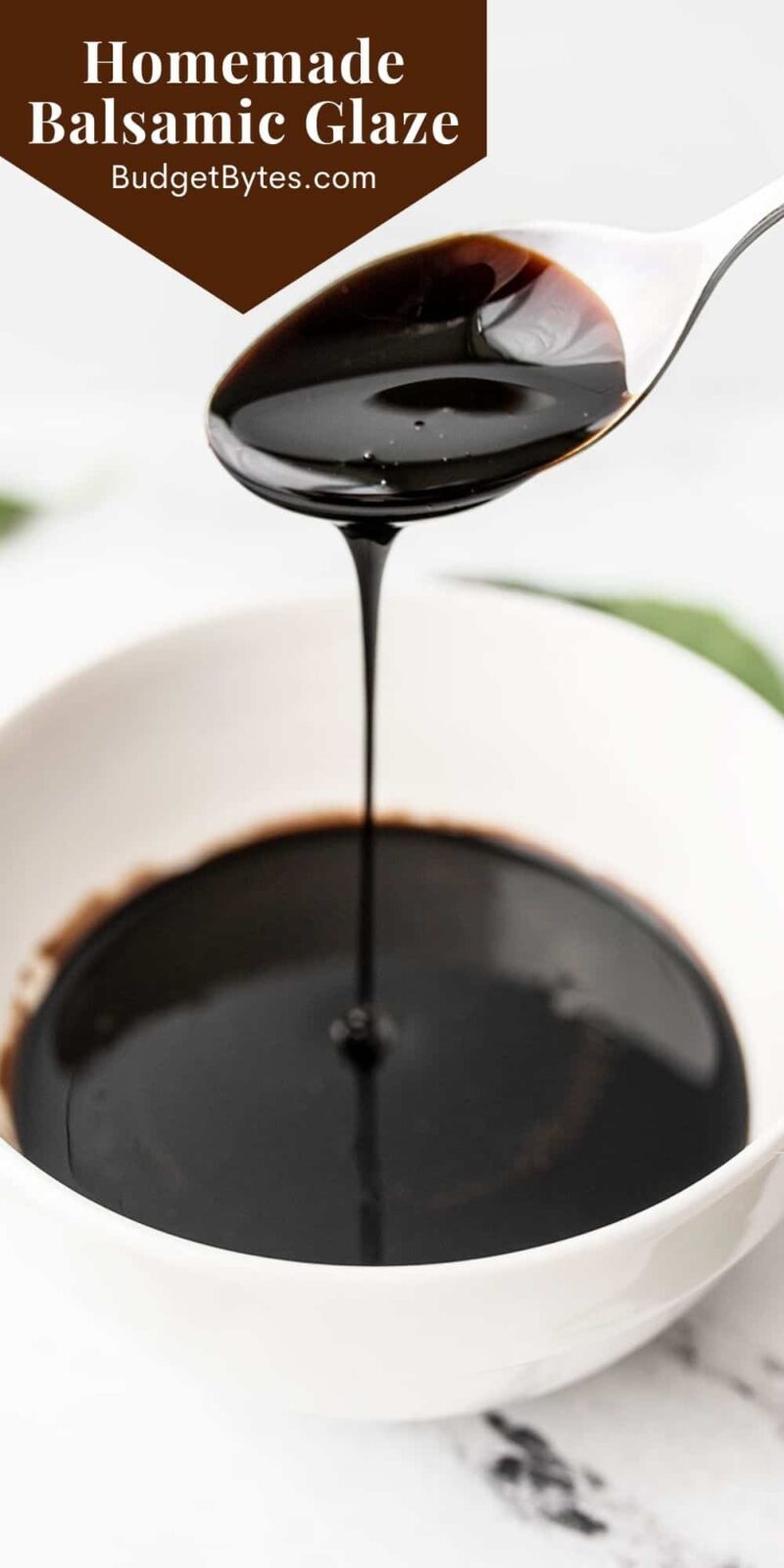
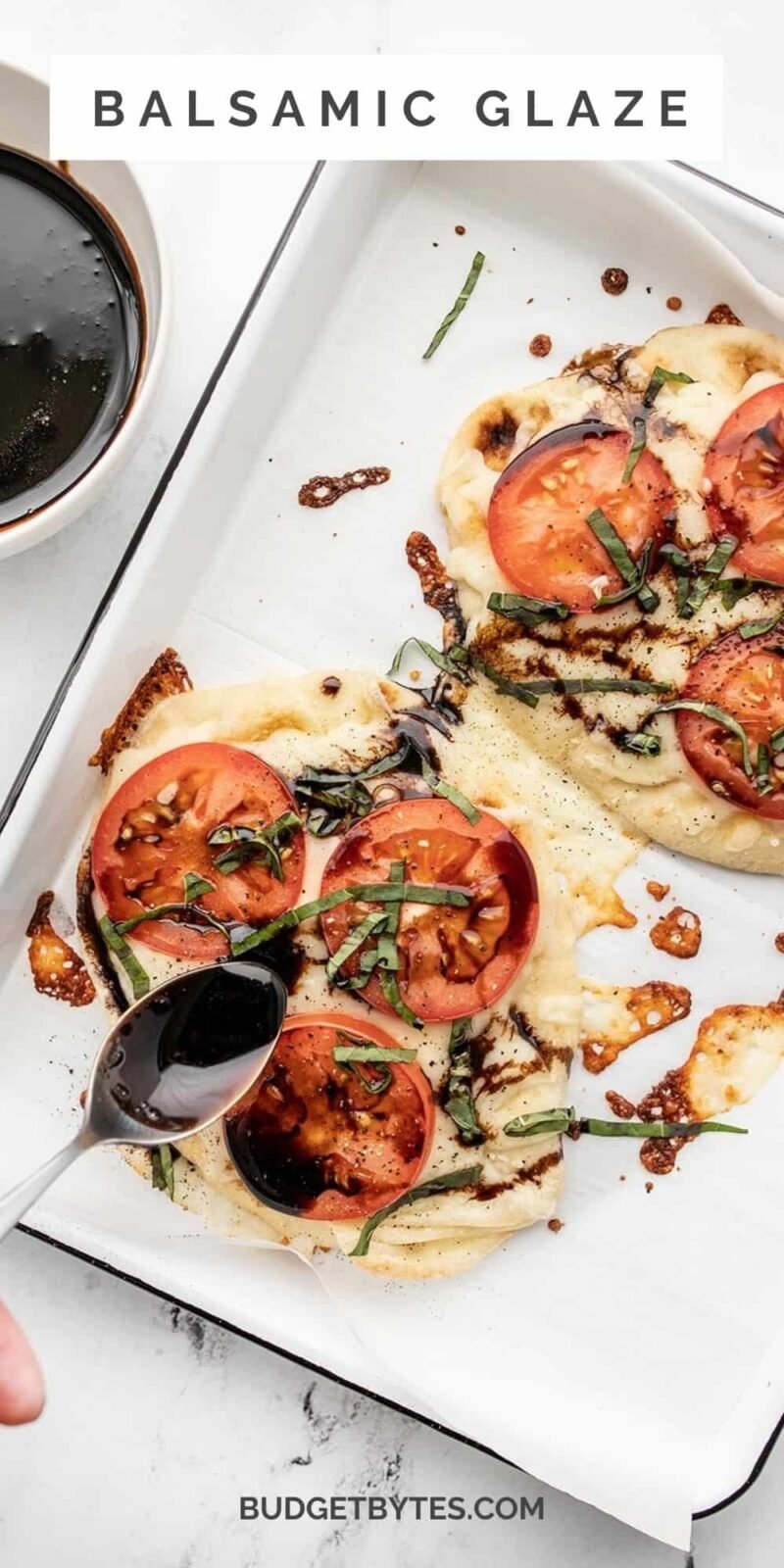
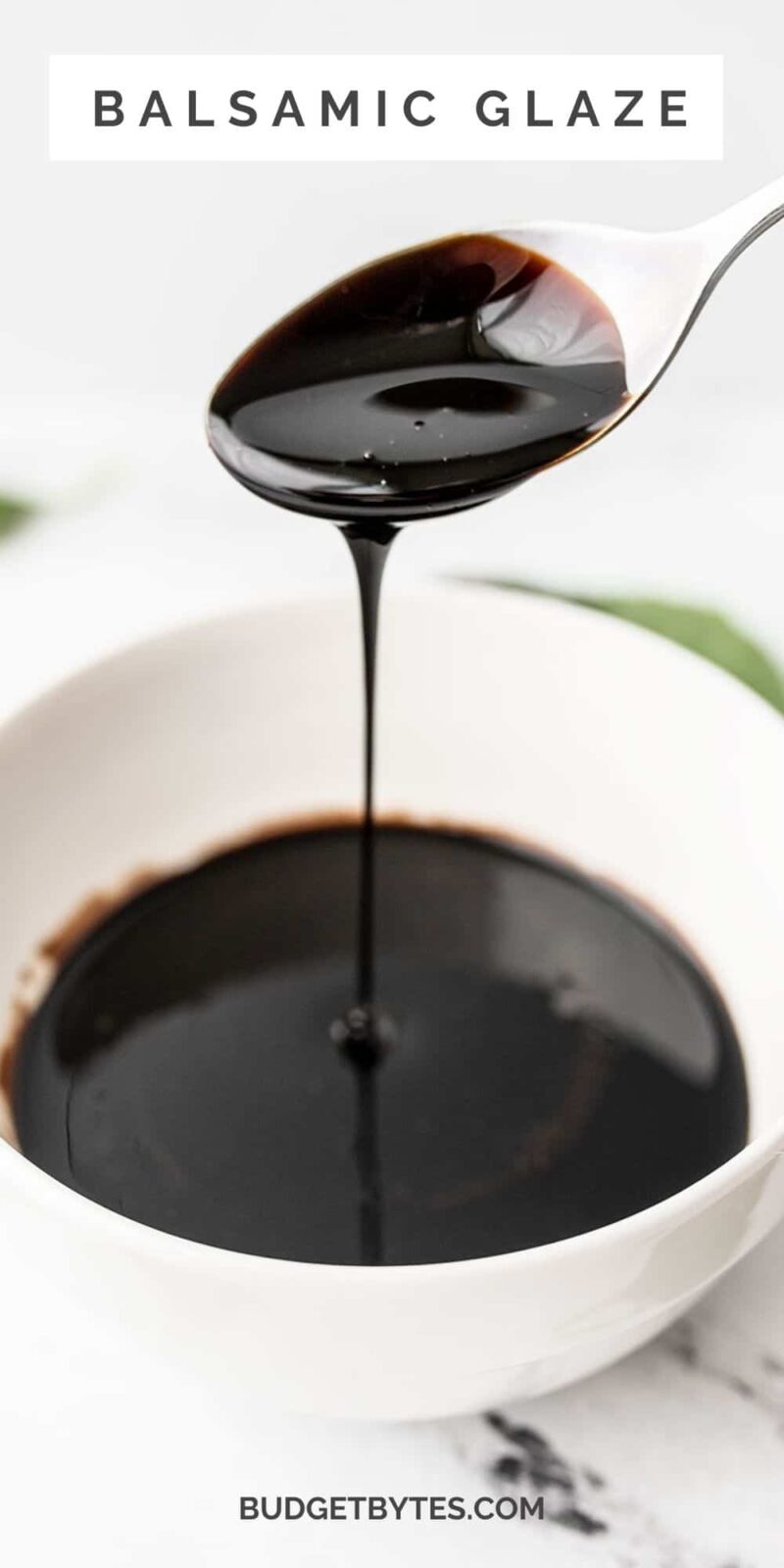
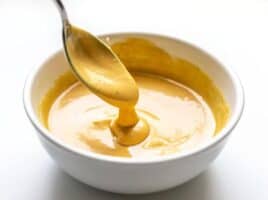
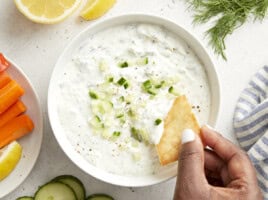
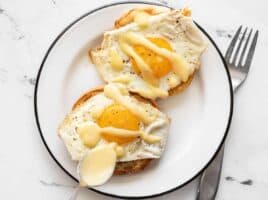
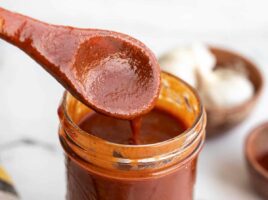
Can I use granulated sugar instead of brown sugar
Yes!
Excellent! Easy to follow! Thank you
Can I use stevia instead of brown sugar?
Unfortunately, I don’t think it would have the same outcome!
Can I use dark brown sugar for this recipe?! Thanks in advance for your help! 😊
That’s fine!
If I substitute honey for the brown sugar, what measurement would you recommend? My auto-immune disease doesn’t allow me to consume regular sugar products, however honey or coconut sugar are acceptable. TY.
I would try 1 tbsp of honey!
Been looking for this recipe! Thanks!
This glaze is delicious! Made it 2 weeks ago and making another batch today. Love the tang factor!
Thank you so much for posting Osama Glazer so expensive so I bought a bottle a pretty decent balsamic vinegar and I had the brown sugar so I can make mini servings for a fraction of the cost by making it myself🙌
Delicious and so simple!
Could you use white balsamic vinegar? If so, any taste difference?
Yummy. Thank you. Lovely recipe
lWhat brand of Balsamic vinegar a good one.where can I purchase it in Atlanta Dunwoody,Georgia
We’re not fussy about the brand, Norma! Any grocery store should have a good selection.
Can I use honey instead of the brown sugar ?
That should be fine, just note that you might be able to taste that honey flavor might come through and effect the taste slightly.
How long can I store it? Thank you!
You can keep the leftover glaze in a closed container in the refrigerator for about two weeks!
Hi Beth,
I got off from work tonight and had a plan in place for dinner. A few days ago, I’d made a nice omelette with jalapeno and cheddar sausage links and wanted to make it again. As soon as I got home, I switched gears bc I realized I hadnt yet made the couscous I bought a week ago. So I pivoted to jalapeno and cheddar sausage links over couscous. It needed something more though and I thought about a sauce of some sort. At 48, Ive made many meals and am more than capable in the kitchen. But making sauces is something Ive rarely tried. The sauces I have made in the past were a mixed bag. So I decided to google How to Make a Balsamic Glaze bc I love the idea of that sauce over porn and couscous absorbing the sauce. Your recipe was one of the first results and I figured what the heck, so I came here and saw how easy it was to make and felt pretty confident I could make the glaze with your recipe.
And I did.
Sort of.
I only have white balsamic vinegar and granulated white sugar, so I went with those, using the same amounts you listed.
I have to say that the sauce really made the meal great. I was blown away by how much I enjoyed it, even though my sauce differed from your recipe.
Thanks for posting this preparation method. You helped transform a nice meal into a great one.